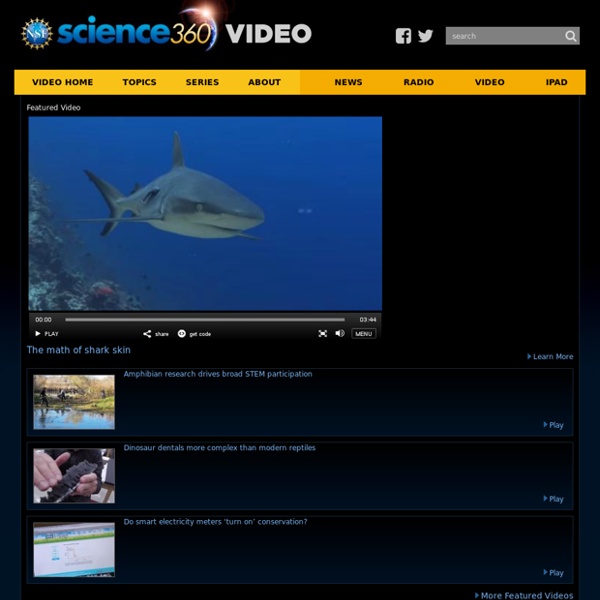



NOVA Can Wind Turbines Make You Sick? Residents living in the shadows of wind turbines say the sound is making them sick. But so far the science isn't there. Radio3 Scienza Access key La navigazione di questo sito è agevolata dalle access key, tramite le quali è possibile accedere alle funzioni e ai contenuti principali del sito. Sono state definite le seguenti access key [0] Accessibilità (questo testo) [1] Home page [2] Contenuti della pagina [3] Inizio della pagina [4] Altre pagine del sito [5] Funzione di ricerca
Explore, Play, Discover: Websites & Activities Search form Search Low-cost, teacher-tested activities for the classroom and the curious. Science of Cooking • Explore the science behind food and cooking with recipes, activities, and Webcasts.PreviousNext Athletics Circular motion is common to almost all sporting events. Whether it is sports car racing or track and field, baseball running or ice-skating, the motion of objects in circles is a common observation of sports viewers around the world. Like any object moving in a circle, the motion of these objects that we view from the stadium bleachers or watch upon the television monitor are governed by Newton's laws of motion. Their circular motion - however brief or prolonged they may be - is characterized by an inward acceleration and caused by an inward net force. The mathematical analysis of such motions can be conducted in the manner presented earlier in Lesson 2.
NOVA scienceNOW Can Wind Turbines Make You Sick? Residents living in the shadows of wind turbines say the sound is making them sick. But so far the science isn't there. From NOVA Next | Jun 27, 2018 Tre Le Storie - Home l'appuntamento quotidiano con Corrado Augias: la stretta attualità, la cultura, la politica e le storie che cambiano il nostro Paese. Il popolare giornalista e scrittore affronterà, ogni giorno, diverse tematiche con il contributo di grandi ospiti, in un viaggio quotidiano alla scoperta degli italiani. Anche quest’anno, in studio, un pubblico speciale sempre diverso: studenti e docenti di licei, Università, Accademie d’arte e musicali saranno protagonisti interagendo con domande, curiosità ed osservazioni. Dieci anni di programmazione, più di millecinquecento puntate. "Le Storie - diario italiano" è una "piccola trasmissione", due poltrone e pochi ospiti in studio, ma d'altra parte l'impegno dichiarato sin dall'inizio è stato quello di fare e indurre a fare "qualche ragionamento". Studenti e professori che volessero partecipare in studio alla trasmissione LE STORIE - DIARIO ITALIANO, possono farne richiesta scrivendo a lestoriescuole@rai.it
125 Great Science Videos: From Astronomy to Physics & Psychology Astronomy & Space Travel A Brief, Wondrous Tour of Earth (From Outer Space) - Video - Recorded from August to October, 2011 at the International Space Station, this HD footage offers a brilliant tour of our planet and stunning views of the aurora borealis.A Universe from Nothing - Video - In 53 minutes, theoretical physicist Lawrence Krauss answers some big enchilada questions, including how the universe came from nothing.A Year of the Moon in 2.5 Minutes - Video - The Lunar Reconnaissance Orbiter has been orbiting the moon for over a year. The footage gets compressed into 2 slick minutes.A Day on Earth (as Seen From Space) - Video - Astronaut Don Pettit trained his camera on planet Earth, took a photo once every 15 seconds, and then created a brilliant time-lapse film.Atlantis's Final Landing at Kennedy Space Center - Video - After more than 30 years, the space shuttle era comes to a close. Video runs 30 minutes.
DnaTube.com - Scientific Video and Animation Site Science - 6th Grade Core Course Description Introduction Science is a way of knowing, a process for gaining knowledge and understanding of the natural world. The Science Core Curriculum places emphasis on understanding and using skills. 100 People: A World Portrait Weekly Reader ScienceSpin November 2011 Social Studies/Cross-Curriculum Grade 1 | 16 issues | $4.75 Skill building kicks into high gear! Children explore nonfiction text and build general knowledge while increasing reading comprehension, vocabulary, and critical-thinking skills. Born to Learn ~ You are Born to Learn